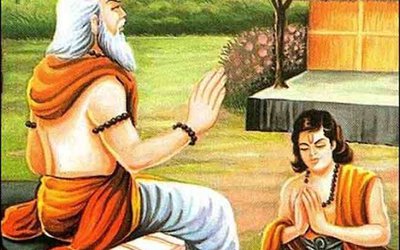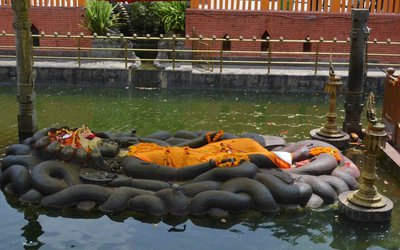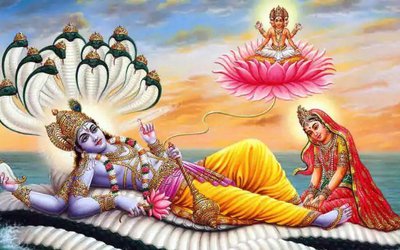
Nepali Hindus are observing Gai Puja or cow worship, Goru Puja or ox worship and Mha Puja or worship of the self across the country today on the fourth day of the five-day-long Tihar festival. Tomorrow is November 15 and Sunday the fourth day of Tihar.
Govardhan Puja rituals are observed today with the replicas of the Gai and Govardhan Mountain made out of the cow dung.
The rituals are linked to the Hindu God Sri Krishna who, according to the legend, lifted the Govardhan Mountain by his hand and protected the people of a place called Gokul from torrential rains caused by Indra, the God of rain.
It is believed that the rain God was angered and thereby caused the heavy downpour.
Similarly, ox is worshipped today as it is a very useful animal in different agricultural works in Nepal which is a predominantly agricultural country.
Likewise, the people of the Newar community observe the Mha Puja ritual in the evening today. Mha Puja is the worship of the self.
Mha Puja is based on the religious belief that the soul or self is most important in the world and that if the soul is satisfied, the gods are also satisfied and one’s life becomes meaningful and prosperous. Nepal Sambat, an indigenous calendar of Nepal also begins today.
Nepal Sambat was launched by Shankhadhar Sakhwa by relieving the people of Nepal off debt during the rule of Lichchhavi King Raghavdev.
Recognizing the contribution of Shankhadhar Sakhwa to the country and people, the government led by the then Prime Minister Krishna Prasad Bhattarai had announced Sakhwa a national luminary on November 18, 1999.
Govardhan Puja 2020: Date, auspicious time and significance of the festival
Devotees of Lord Krishna perform the Govardhan puja or Annakut on the Pratipada Tithi, Shukla Paksha (waxing phase of the Moon) in the Hindu month of Kartik. This day stands fourth in the five-day-long Diwali festival that commences with Govatsa Dwadashi puja or Dhanteras (in some regions) followed by Naraka Chaturdashi and Lakshmi Pujan. This festival is associated with the legend of Lord Krishna's triumph over Indra, the King of the Devas. Read on to know the Govardhan Puja 2020 date, puja time and other details.
Govardhan puja is performed by devotees of Lord Krishna. It is believed that Lord Krishna defeated God Indra, the King of the Devas on this day
Govardhan Puja usually falls on the day after Diwali and is also known as Annakut Puja. Govardhan Puja 2020 will be celebrated on 15 November (Sunday).
Govardhan puja is performed by devotees of Lord Krishna. It is believed that Lord Krishna defeated God Indra, the King of the Devas on this day.
It is said that in order to protect the residents of Gokul, Lord Krishna lifted the Govardhan Parvat with his little finger after Lord Indra caused massive rains.
Legend has it that the people of Braj region would make vast offerings to Lord Indra to seek his blessings. Once Lord Krishna, when he was still a little boy, wondered why one should resort to appeasement, believing that Bhakti or devotion is the only way to connect with divinity. Realizing his point, Nanda and the brijwasis decided to end the tradition of appeasing Lord Indra.
Angered at their decision, Indra lashed the region with torrential rains and thunderstorms. To end the people's sufferings, Krishna lifted the Govardhan Parvat with his Kanishtha or little finger and provided shelter to people and their cattle and livestock.
Having continued with his destruction for seven days and nights, on the eighth day, Lord Indra conceded defeat.
On the day of Govardhan Puja, people cook and offer around 56 dishes, called chhappan bhog, to Lord Krishna as a mark of gratitude.
People also worship cows on this day and in North India, devotees recreate Govardhan Parvat using cow dung. During puja, people offer water, fruits flower and lite diyas (earthen lamps) and incense sticks.
In Maharashtra, Govardhan Puja is celebrated as Bali Pratipada or Bali Padva. It is believed that Vamana, an incarnation of Lord Vishnu won against Asura King Bali and pushed Bali to paatal lok (the underworld). It is said that due to a boon given by Lord Vamana, Bali visits Prithvi Lok from palatal Lok on this day.
Govardhan Puja 2020: Auspicious time
Govardhan Puja Sayankala Muhurat: 3:19 pm to 5:27 pm.
In religious texts, Govardhan Puja celebrations are done during Pratipada Tithi of Kartik month. The Pratipada Tithi begin at 10:36 am on 15 November and ends at 7:06 am on 16 November.
Govardhan Puja significance
Devotees hail Shri Krishna and thank the Govardhan Parvat that he lifted with his little finger to save the people of the Braj Bhoomi after Indra Dev caused massive floods to avenge them. They offer a variety of food preparations to the Lord and the Govardhan parvat. In some places, Chhapan Bhog, a platter consisting of 56 recipes are made and offered to the deity as a mark of gratitude. The food is presented as a miniature mountain, and hence it is also referred to as Annakut. Devotees in the Braj region (consisting of modern-day Mathura and Vrindavan) circumambulate the remains of the Govardhan Parvat and pay obeisance to it.
Govardhan Puja legend
As per one of the legends mentioned in Bhagavata Purana, the people of the Braj region would make vast offerings and sacrifices to appease Lord Indra to seek his blessings. Once, Lord Krishna, who was then a little boy, wondered why one should resort to appeasement. He strongly believed that appeasement should be discouraged and Bhakti (devotion) must be the only way to connect with God. After realizing that Krishna raised a pertinent point, Nanda and the Brijwasis ended the tradition of offerings to Indra Dev. Instead, they chose to do their Karma.
Their decision to terminate the tradition enraged Indra. And to avenge the insult, he lashed the region with torrential rains and thunderstorms. Indra's wrath resulted in the loss of property and livestock. People got displaced and suffered massive losses. And to end their sufferings, Krishna lifted the gigantic Govardhan mountain on his little finger (Kanishtha) and provided shelter to people, the cattle, and livestock.
Indra continued with his destructive plan for seven days and seven nights, and on the eighth day, conceded defeat. Thus, he bowed before the little boy, who was the incarnation of none other than Lord Vishnu.
Sources: Various Agencies
- Nepal’s Largest All-Female Hackathon 2025 Concluded
- Jul 15, 2025
- Nepal Needs a Coordinated Security Mechanism and De-radicalisation Program to Counter Terrorism
- Jul 15, 2025
- FOODMANDU Committed to Make ‘Life Ajhai Better’
- Jul 15, 2025
- Om Vedic Foundation Inaugurates with Grand Ceremony
- Jul 15, 2025
- Weather Forecast: Generally Cloudy Across The Country heavy rain in one or two places in Koshi,Gandaki, Lumbini, and Karnali Province
- Jul 15, 2025















